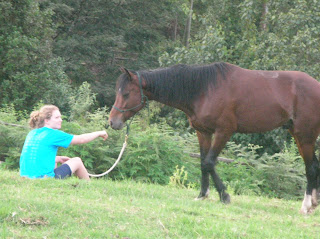Here are a couple of ramblings I've made in my diary, just different discoveries I've been making in my time here. Mostly unedited things, forgive me if any of this confuses you...
Pressure Motivates, but its the release that teachesIn most cases, this sentence is like a light turning on. But soon, the horse even seems to figure out that plan, and it's no longer any good! The key is to find the amount of pressure needed. For instance, with a more dominant, left-brained horse, the pressure might be greater, or there may be a need for more incentive, provocative pressure. BUT one needs to be careful not to push a right-brained horse beyond his pressure limits, as he'll explode or shut down. I guess it all boils down to the principle of 'never ask a trying horse to try', and if it ever becomes 'too much,' retreat! Also, with a more dominant horse, you've got to find your phase 4, but pressure is more than physical pressure.
Principle to PurposeAs with anything in life, one always hits the question of ‘why?’ And, I’ve realized that 'just because' is a valid answer. I’ve been discovering that the beauty of communication and relationship is that it's not always an immediate, life or death situation. Sometimes, there isn’t a point to relationship. Beauty is just for the moment. Just because. Why not? As I am a person who quite quickly deems things as pointless, boring, or unnecessary, it's been so valuable to learn to ‘just be.’
Now, with horses, is it enough for me to answer ‘because,’ or do they need something more, a reason behind relationship? OR, it is that when I supposedly answer ‘just because,’ they are in fact receiving it as pressure, or perhaps, a different element of perfection – in that I’m expecting them to ‘just be’ when in fact they NEED to move around, and be provocative. In which case, ‘just being’ is a huge pressure in itself. Also, is it possible to do something without a reason, but still do it well? For instance, I’d like the horse to do a perfect circling game, just because. Perhaps when ‘just because’ is in the picture, the word perfect can’t also come into the equation… hmmm, stuff to ponder…
Firm vs Friendly, Assertive vs Soft Firm versus friendly, assertive versus soft. What is the difference, and how can the receiving party really tell the difference?
I think that one word to sum it all up is ‘Respect.’ I find that the horses here interpret Friendly Game as their opportunity to disrespect me, and when I'm firm, they automatically think that I'll disrespect them. I want to show them that in both there is respect. 'I'll scratch your back, if you scratch mine, but this is MY personal space.' ‘Don’t be afraid, but do what I say…’
We tend to teach our horses assumptions, and in essence, rather than learn to respect us, they learn to respect our tools and then only in certain scenarios. This is not true communication with the person/figure in question – rather, it is an association of certain behaviour with different tools/items/materials, and the realization that those things require certain responses. So rather than communicating with the human who has a whip at hand, they run in a circle on adrenaline. We teach assumptions, because we think the horse is being so good, and responding so quickly. What we don't realize is that they aren’t really responding to our request.
 Friendly game with Noita, the best time of day for bonding,
Friendly game with Noita, the best time of day for bonding, 









 Driving Game, our conversations go something like this: "Imagine that your ears are back," "...But his ears are forward" "Yes, its good (Nzuri San/Saafi Sana) he is paying attention. Your ears must be back though"
Driving Game, our conversations go something like this: "Imagine that your ears are back," "...But his ears are forward" "Yes, its good (Nzuri San/Saafi Sana) he is paying attention. Your ears must be back though"



















